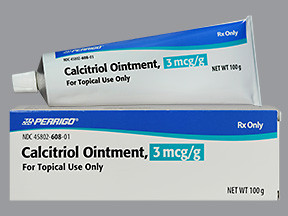CALCITRIOL OINTMENT - TOPICAL
PHONETIC PRONUNCIATION: (KAL-si-TRYE-ol)
COMMON BRAND NAME(S): Vectical
GENERIC NAME(S): calcitriol
Uses
USES: This medication is used to treat psoriasis. Calcitriol is a form of vitamin D. It works by slowing down the growth of cells.
How to use CALCITRIOL OINTMENT - TOPICAL
HOW TO USE: Use this medication on the skin only. Wash the affected area and pat dry. Apply a thin layer of medication usually twice daily, in the morning and in the evening, or as directed by your doctor. Apply only to the areas of skin affected by psoriasis. Gently rub in. Wash your hands after using, unless you are using this medication to treat the hands. Do not apply calcitriol to the face, in the eyes, nose, or mouth, or inside the vagina. If you do get the medication in those areas, flush with plenty of water. Do not apply to a larger area of skin, apply more often, or use longer than prescribed. Your skin will not improve any faster and this may increase the risk of side effects. Do not cover, bandage, or wrap the area unless directed to do so by your doctor. Do not apply to more than one-third of your body. Do not use more than 1 ounce (30 grams) daily. Use this medication regularly to get the most benefit from it. To help you remember, use it at the same times each day. Inform your doctor if your condition does not improve or if it worsens. You should usually begin to see an improvement in your skin condition after 4 weeks of treatment.
Side Effects
Precautions
Interactions
Overdose
Images
Reviews
Faq for CALCITRIOL OINTMENT - TOPICAL
Calcitriol ointment is used to treat certain skin conditions, such as plaque psoriasis, by reducing the growth of skin cells and reducing inflammation.
Apply a thin layer of the ointment to the affected area and gently rub it in until it is evenly distributed. It is usually applied once daily, but your doctor may provide specific instructions.
Calcitriol ointment is usually not recommended for use on the face. However, you should consult with your doctor to discuss potential off-label usage.
Common side effects include itching, redness, burning, stinging, or peeling of the skin. If these symptoms persist or worsen, contact your doctor. Serious side effects are rare but seek immediate medical attention if you experience severe skin irritation or allergic reactions.
It is important to consult with your doctor before using Calcitriol ointment during pregnancy or breastfeeding. They will weigh the potential benefits against the risks and provide you with guidance.
The effects of Calcitriol ointment may vary. It typically takes several weeks of regular use to see improvement in the treated skin condition. Follow your doctor's instructions and be patient with the results.
It is important to inform your doctor about all the medications you are taking, including prescription, over-the-counter, and herbal products. Some medications may interact with Calcitriol ointment, so it's essential to receive proper guidance.
If you forget to apply the ointment, apply it as soon as you remember. However, if it is close to the time for your next application, skip the missed dose and continue with your regular schedule.
Do not discontinue the use of Calcitriol ointment without consulting your doctor, even if your symptoms improve. They will advise you on the duration of treatment to prevent a recurrence of symptoms.
Disclaimer
IMPORTANT: HOW TO USE THIS INFORMATION: This is a summary and does NOT have all possible information about this product. This information does not assure that this product is safe, effective, or appropriate for you. This information is not individual medical advice and does not substitute for the advice of your health care professional. Always ask your health care professional for complete information about this product and your specific health needs.


No Reviews Yet